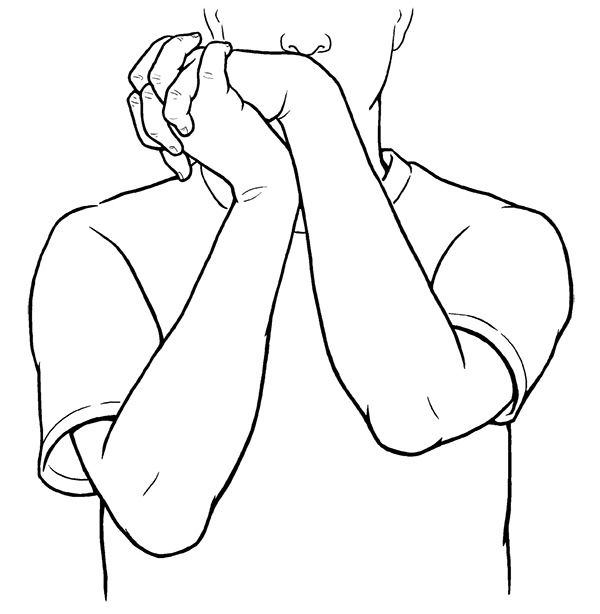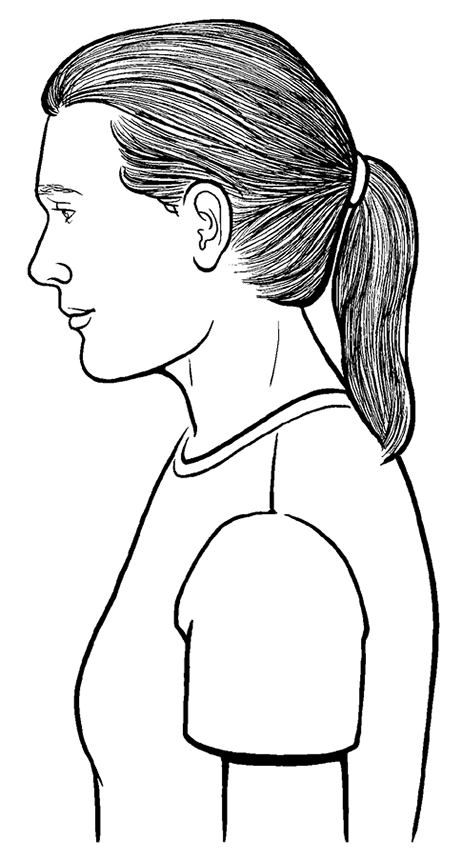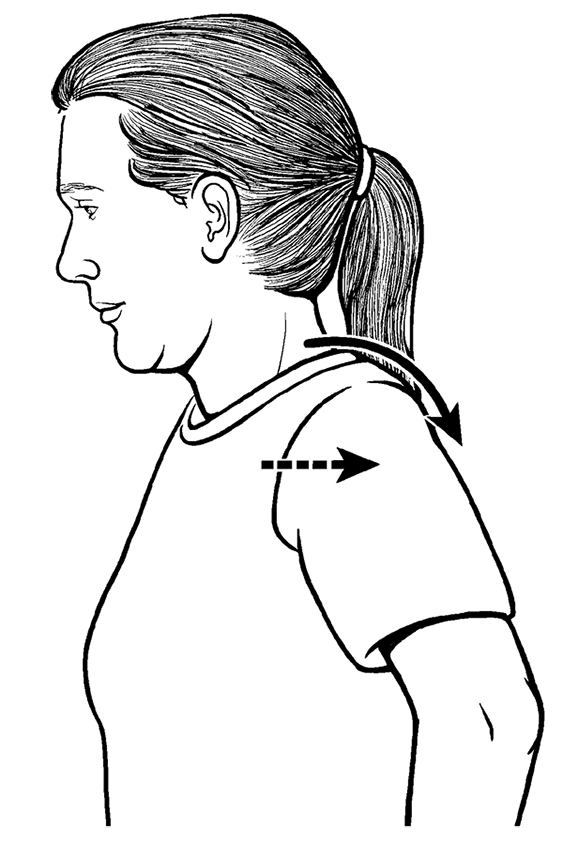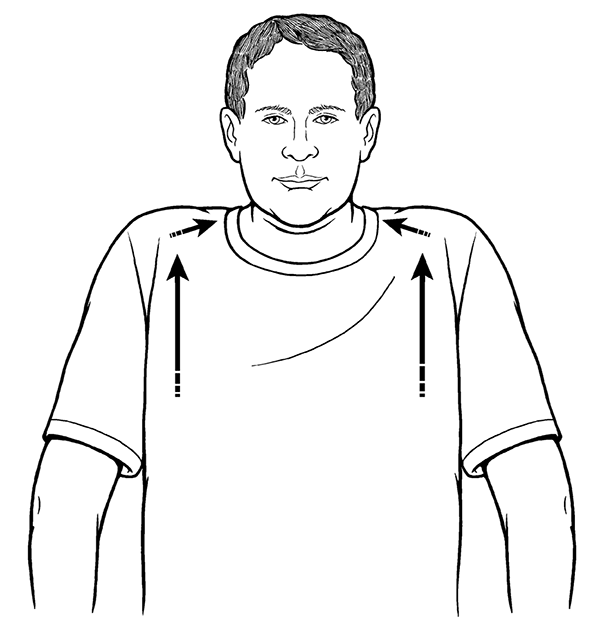Chinese Healing Exercises (13 page)
Read Chinese Healing Exercises Online
Authors: Steven Cardoza
Tags: #Taiji, #Qi Gong, #Daoist yoga, #Chinese Healing, #Health, #medicine, #remedy, #energy

I
n order to extend and stretch your thumb, you will need to reposition both hands. Turn your left hand so that your palm faces the center of your chest, and your left thumb is pointed upward toward the sky. Place the weblike portion of your right hand between the thumb and index finger up against the weblike portion of the left hand. Grasp your left thumb with your right thumb and index finger. Once in this position, do not let your right hand move in space; keep it completely stationary. Move your left arm exactly as before, and that will pull your thumb through your right hand. Repeat two more times. Then, switch hands and do the above again to extend and stretch your right hand.
3. Shake Out Fingers, Hands, and Arms
Purpose
Physical:
Brings more blood into the hands, improves circulation, loosens tight muscles, softens tendons, relaxes ligaments.
Energetic:
Helps break up local pockets of stagnant qi and discharges it from your hands and fingers.
Techniques Used
Shaking/Vibration.
Method
Standing, or sitting in an armless chair or stool, let your arms hang comfortably at your sides. Keep your hands as relaxed as you are able, and do not actively engage any muscles in them. Keep your forearms as relaxed as possible too, since most of the muscles in the fingers and hands attach in the forearms. Using the muscles in your upper arms and shoulders, shake out your hands as though you are trying to shake off oil or anything similar stuck to your hands. Moving your hands in many directions (circles, forward and back, side to side) will provide the most thorough benefits. All of those directional motions should come from your upper arms and shoulders, not your wrists and hands, so if any direction is too awkward for you in the beginning, skip it for now rather than using any hand muscles.
There's no set amount of time you need to do this exercise, but you should do it long enough so that your hands feel noticeably looser and more relaxed. This is one instance where longerâup to a few minutesâmay be better, as long as there is no pain.
4. Wrist Rolls
Purpose
Physical:
Opens the joint spaces in the wrists; promotes movement of the synovial fluids, helping to lubricate the wrist joints; further softens the tendons at the wrist.
Energetic:
Stimulates the arm Jing River points, primarily found at and slightly above the wrists. The Arm Jing River points are classically used to clear both heat and cold sensations, specifically centered around the chest. They are useful for cough, asthma, throat, and respiratory problems, especially those associated with heat or cold. They are also useful to help resolve local pain and are beneficial in treating arthritis and various types of tendinitis.
Stimulates the Arm Shu Stream points. The Arm Shu Stream points are found at various places around the circumference of the hand, although the Yin Shu Stream points of the Lung, Pericardium, and Heart are directly at the wrist and are stimulated more strongly. Stream points are most commonly used to treat Bi syndromes (more colloquially called Painful Obstruction syndromes), which are often the same as or associated with various types of arthritis pain. This is especially true if Damp is part of the pathogenic picture, which is almost always the case in Bi syndromes. That Damp may or may not visibly manifest as swelling or edema.
Technique Used
Active joint mobilization.
Method
Standing or sitting, interlock your fingers in front of you at about chest height or slightly higher, in a prayer position
(
Fig 4.4A
on next page
).
Keep your shoulders relaxed and your elbows down, pointing toward the ground throughout this exercise. Imagine there is a small ball between your hands at the center of your palms. Do your best to keep that ball stationary in space, as though it's fastened to the top of a pole, and rotate your hands around that ball in one direction, keeping your fingers interlocked and palms together. While you are rotating your hands around that imaginary stationary ball, one wrist will move higher while the other moves lower
(
Fig 4.4B
).
That will make your forearms move up and down slightly, in a piston-like motion. You'll
also notice that they rotate some, following your wrist motion. That's natural, and normal in this exercise.
Do twenty to twenty-five rotations in one direction, and then reverse directions for an equal number. You may feel or even hear pops and clicks in your wrists. That may happen more in one direction than the other. That's okay. Over time, they will diminish. If you want to do more than twenty-five repetitions, that's okay too. For most people, more repetitions will make those clicks disappear sooner.
 Figure 4.4A (Wrist Rolls)
Figure 4.4A (Wrist Rolls)
 Figure 4.4B (Wrist Rolls)
Figure 4.4B (Wrist Rolls)
Five
Shoulder and Arm
The shoulders are an often neglected part of the body. Most people only give them any thought when there's an obvious problem, such as arthritis, bursitis, frozen shoulder or a rotator cuff injury. From a purely anatomical perspective, consider that they are connected to your neck and upper back. While many people complain of neck and upper back pain, few take into account that shoulder tension may be either a primary cause or a contributing factor.
On an energetic level, the shoulders directly connect all of the acupuncture Arm meridiansâLung, Heart, Pericardium, Large and Small Intestines, and Sanjiao/Triple Burnerâas well as the Left, Right, and Central core channels used in qigong with the torso, where those pathways continue. They are the site of the Shoulder's Nests, which directly affect the health of the heart and lungs as well as amplify qi flow through the Side Channels. While learning to mobilize the shoulder blades directly is most advantageous, having freely movable and functionally strong shoulders is a big step in that direction. The vertebrae between the shoulder blades influence the health of the heart and lungs both neurologically and energetically, and there are points along the inner borders of the shoulder blades that have similar influences.
The openness and free flow of qi through your shoulders and arms is a two-way street. Each must function equally well on all levels for either to function optimally. This should help you understand how the health of your shoulders and arms is crucial to your overall health. The exercises in this section will assist you to that end.
1. Shoulder Rolls
Purpose
Physical:
Mobilizes the shoulder joint; engages and softens the muscles of the shoulder, upper back and lower neck; massages the thoracic and axillary lymph glands; gently prepares the shoulders for all the following exercises.
Energetic:
Activates energetic structures deep within the shoulder girdle (the Shoulder's Nest), which help maintain various energetic connections between the torso and arms; activates acupuncture meridian pathways, notably the Heart and Lung meridians, benefiting their functions. Activates the acupuncture points of the upper back that lie between the shoulder blades. These also primarily benefit the Heart and Lungs. Activates the acupuncture points between the front of the shoulders and the chest (the front of the Shoulder's Nests), which primarily benefit the Lungs.
Technique Used
Active joint mobilization.
Method
Standing, or seated in an armless chair, let your arms hang at your sides. Keep them as relaxed as you can throughout this exercise
(
Fig 5.1A
).
Move your shoulders forward and slightly upward, compressing your chest a bit. Feel your shoulder blades spread away from your spine
(
Fig 5.1B
).
Then, in a rolling motion, move your shoulders upward toward your ears. In this position, they should be hunched up, but not too tight
(
Fig 5.1C
).
Continue to circle your shoulders rearward. In this position, feel your shoulder blades compressed toward your spine while the front of your chest opens
(
Fig 5.1D
).
Finally, continue to circle your shoulders downward until they return to their starting position
(
Fig 5.1A
).


Figure 5.1A and 5.1B (Shoulder Rolls)


Figure 5.1C and 5.1D (Shoulder Rolls)
Throughout all those landmarks, keep your shoulder motion smooth and constant, making rearward circles at a moderate pace, one circle every two or three seconds. Do ten to fifteen circles, and then reverse direction for the same number of circles. If this is the only shoulder exercise you do on any given day, you can do up to fifty circles to really open the shoulders and related energetics.
2. Shoulder Shrug and Drop
The physical and energetic purposes are the same as in the Shoulder Rolls. This provides an additional physical benefit for the upper shoulder and lower neck muscles (mainly, the trapezius). Energetically, there is an additional benefit to the local Gall Bladder meridian acupuncture points. This more strongly releases shoulder tension and may help reduce headaches.
Techniques used
Joint mobilization, muscle tense/relax, guided breathing.
Method
Standing, or seated in an armless chair, let your arms hang at your sides. Keep them as relaxed as you can throughout this exercise. Begin as in the previous exercise. In a rolling motion, move your shoulders forward and then upward toward your ears. This time, shrug your shoulders tightly, and hold them tight for two to three slow, deep breaths
(
Fig 5.2A
).
Imagine they are being pulled up by strings. Then, on a quick exhalation, imagine the strings are suddenly cut, and drop your shoulders straight down
(
Fig 5.2B
).
This should feel like a release, and not like a push downward. Then reverse the direction of your shoulder shrug, moving your shoulders circularly rearward and then up. Hold the shrug tightly, breathe, and release as before. Do a minimum of five in each direction for a total of ten shrugs.
 Figure 5.2A (Shoulder Shrug and Drop)
Figure 5.2A (Shoulder Shrug and Drop)
 Figure 5.2B (Shoulder Shrug and Drop)
Figure 5.2B (Shoulder Shrug and Drop)
3. Shoulder Blade Protraction and Retraction with Arm Rotation
Purpose
Physical:
Moves the shoulder blades toward and away from the spine to free any lingering tension between the shoulder blades. Opens the front of the chest. Pumps the inner (front) surface of the shoulder blades toward and away from the back of the ribcage. This massages the subscapularis muscles, often a hidden source of shoulder and upper back pain. The arm rotation begins to soften and release tension through the entire arm.
Energetic:
Same as for the Shoulder Rolls. Additionally, there is a small energy center between the front of the shoulder blades and the back of the ribcage. The activation of that center further releases shoulder and upper back tension, and benefits the function of the Shoulder's Nests. The rotational movement of the arms activates qi flow through the Arm meridians, primarily the Lungs, Heart, and Intestines, deepening the benefits begun in the previous shoulder exercises.
Techniques used
Joint mobilization, rotational stretch, guided breathing.
Method
Stand with your arms hanging relaxed at your sides. Breathe in, and on an exhalation, move your arms forward toward the center of the front of your body, keeping your fingers pointing to the ground, while rotating your arms so that the backs of your hands touch, or come as close to touching as you can get
(
Fig 5.3A
).
Your shoulders will hunch forward and slightly compress your chest. Feel your shoulder blades spread away from your spine, while they simultaneously move closer to the back of your ribcage. Feel the muscle of your
arms twist inward, similar to wringing out a wet towel. Then, on an inhalation, move your
arms toward the rear of your body, rotating your arms outward so that the palms of your hands face out to the sides, or slightly rearward if you can
(
Fig 5.3B
).
Feel your shoulder blades squeeze close to your spine, while they simultaneously move rearward away from the back of your ribcage. Feel the muscle of your arms twist outward. The front of your chest opens wide. Cycle forward and back ten to fifteen times, at a rate that is comfortable for your breath. Try to keep your breath smooth and continuous. Do not hold it at any time, neither at the end of the inhalation nor exhalation.
 Figure 5.3A (Shoulder Blade Protraction
Figure 5.3A (Shoulder Blade Protraction
and Retraction with Arm Rotation)
